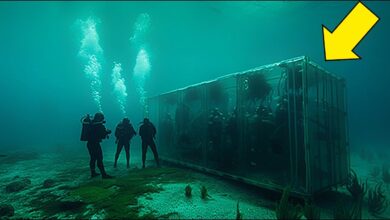Scientists WARN of a MASSIVE Storm That Will Change America Forever?

Our planet’s supervolcanoes are showing activity, raising concerns among scientists. Italy’s Campi Flegrei, near Naples, has seen rising ground levels and frequent earthquakes, suggesting potential danger. However, it’s not the only worry: Yellowstone, with its vast magma chamber, and California’s Long Valley also pose threats. An eruption could cool global temperatures and disrupt ecosystems.
Historically, eruptions like Toba’s in Sumatra and Tambora’s in Indonesia caused volcanic winters, crop failures, and famine. The hypercane, a hypothetical extreme cyclone, could form if ocean temperatures rise drastically, potentially devastating the ozone layer.
Other natural threats include massive solar flares, which could collapse the global power grid, and gamma-ray bursts from space, which could strip Earth’s protective layers. Even though these events are rare, they illustrate the unpredictable dangers our planet faces.
In September 1859, astronomer Richard Carrington spotted a large flare on the Sun, and a few days later, the energy from the solar flare reached Earth, causing the Northern Lights to appear over Cuba and burning out telegraph lines around the world. Known as the “Carrington Event,” it was the most powerful solar storm ever recorded. In 2012, a similar event narrowly missed Earth, and if it had happened, it could have knocked out the global electrical grid, causing trillions of dollars in damage.
In addition, El Niño and La Niña affect weather around the world. El Niño warms the equatorial Pacific, creating warm, dry weather in North America, while La Niña cools the ocean, causing a severe hurricane season in the Atlantic. This year’s hurricane season is expected to be particularly severe, with the number of storms expected to exceed 20.
Other unique natural phenomena include “desert roses” formed from the mineral gypsum in arid desert regions; “Blood Falls” in Antarctica, which are red due to their high iron content; “snow blades” (penitentes) that appear in areas with high cold, dry air; and the “Eye of the Sahara,” a natural ring in Africa that is concentric in shape, about 25 miles wide, and dates back 100 million years.

The Eternal Flame Falls in Upstate New York has a small waterfall with a hidden flame, fueled by a natural gas seep. Nearby, Hawaii’s Green Sand Beach gets its color from olivine rock from volcanic eruptions. Beaches like those in the Maldives can even glow at night due to photoplankton. The intermittent spring in Wyoming starts and stops due to an underground siphon effect, while earthquake lights sometimes appear before quakes, though scientists don’t fully understand them.
Fire tornadoes can occur when wind traps flames, creating a swirling fire column. The manchineel tree, found in Florida and the Caribbean, is one of the most dangerous due to its toxic sap, which can burn skin and poison nearby water. In Venezuela, the Catatumbo River experiences frequent lightning, and volcanic “dirty thunderstorms” occur when ash and gases collide, creating lightning.
Africa’s Danakil Desert has extreme conditions with toxic waters, while in Canada, Abraham Lake’s ice traps methane bubbles, which release when the ice melts. In Japan, “fish rains” happen when water spouts lift aquatic animals. Indonesia’s Java island hosts an acidic turquoise lake in a volcano, which glows at night from sulfurous gases. Red tides occur when algae bloom, poisoning marine life and causing respiratory issues for humans.
Other natural wonders include Namibia’s bottle trees, Australia’s prison tree, and “red rain” algae blooms. If all Earth’s volcanoes erupted at once, ash and volcanic gases would block sunlight, lower temperatures, and damage ecosystems, potentially leading to mass extinctions. However, volcanoes are too isolated to erupt simultaneously due to separate magma sources.
Earthquakes that occur over a short period of time will cause the ground to deform and release strange gases. Yellowstone appears stable, but if a major eruption occurs, the consequences could be dire: ash could cover a 500-meter radius, affecting agriculture and water systems in the Midwest. Gas and ash rising into the stratosphere could cool the Earth for years. A new study suggests there is more molten rock under Yellowstone than previously thought, but that doesn’t mean there’s an immediate danger.
When you think of volcanoes, the Pacific “Ring of Fire” region is the first place that comes to mind, where three-quarters of the world’s volcanoes are concentrated. Europe, while quieter, is home to Etna, the continent’s most active volcano, which has erupted 200 times. Meanwhile, Iceland has a new volcano that will erupt in July 2023, when the ground cracks and spews lava high into the air. Still, the scientific community is not surprised, having monitored the region for thousands of tremors.
Iceland, home to more than 130 volcanoes, has a seismic monitoring system that helps predict and warn visitors of danger. Authorities often seal off dangerous areas quickly. A 2010 eruption of a volcano south of Iceland closed European airspace for days due to the spread of ash.








